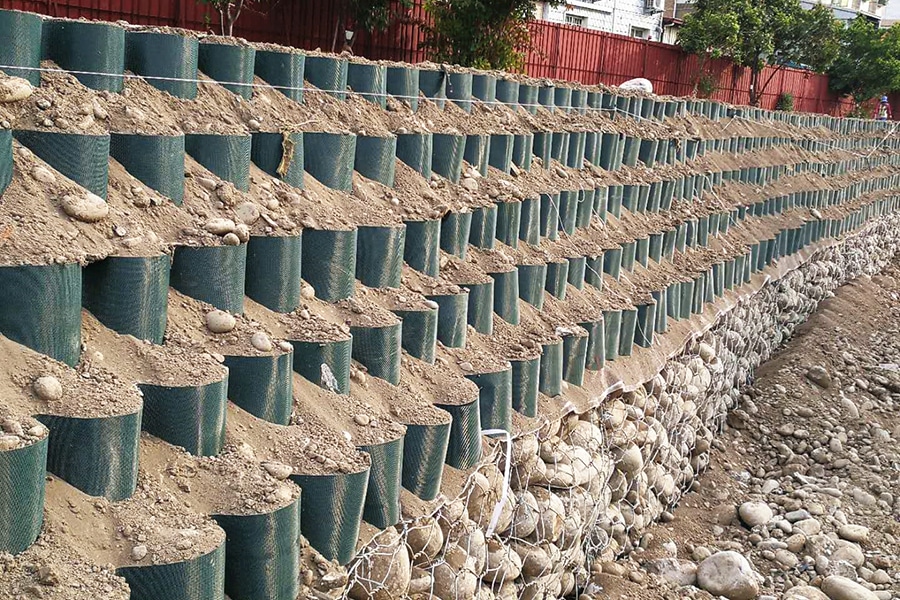Looking to build a retaining wall on a budget but don’t know where to start? We’re here to offer a quick breakdown of the cheapest way to build a retaining wall.
Choosing Your Base Material
Retaining walls are a great way to add a landscaping feature to your backyard, or divide two levels of soil. Building a retaining wall can be a fairly simple task, regardless of size and budget. One of the first steps before breaking ground is choosing the right material. Luckily, there are plenty of options depending on what you are looking for.
- Pressure Treated Wood: This is a great option for those who are looking for the cheapest way to build a retaining wall. Keep in mind, while this might be a great option for your wallet—wood is likely not a long-lasting option. It is worth pointing out that a larger build using wood is no simple task, and might require some additional help, which can quickly add to the cost.
- Concrete Cinder Blocks: Another common favorite, concrete cinder blocks offer long-lasting results at a low cost per square foot. Using these blocks is a good option for those who do not have much experience with bigger projects. While they’re easy to use, they may not offer you that dream backyard aesthetic. If looks are an important factor, this likely isn’t the best choice for your project.
- Bricks: Like the concrete cinder blocks, bricks are relatively easy to install and highly durable. Retaining walls constructed with bricks are a long-lasting, aesthetic addition to any space. Unfortunately, bricks are on the more expensive side of material options and larger projects will require some help.
- GeoCell: A newer, affordable option that eliminates many of the con’s found with traditional materials, is BaseCore Geocell. Geocell is a lightweight, long-lasting, and easy-to-use material that can fit the needs of any project. For use in a retaining wall, Geocell offers natural drainage and a sleek aesthetic. These expandable panels resist corrosion, weather, and chemicals better than any other base material, click here for more information.
Consider Necessary Tools and Additional Materials
Once you have chosen the best material for your retaining wall, it is time to consider what additional items you will need before building. Based on the material you are using to build, you may need to account for drainage, landscaping fabric, labor, tools, and more. Ask yourself these questions:
- Will you need to excavate your construction site to ensure a level surface?
- Do you require any landscaping fabric, or another erosion control product?
- Does your base material require infill? If so, what do you plan on using?
- Do you have ample experience and labor? Or will you need to hire a specialist and some helping hands?
If you choose to use GeoCell, there are only a few things to gather before building – saving time and money:
- You will need an erosion control product, non-woven geotextile is an easy-to-use and affordable option.
- Select your infill. GeoCell is compatible with a variety of infills, whether it be sand, gravel, plants, concrete, etc.
- No specialist is needed, GeoCell is user-friendly with plenty of resources available for installation methods. Whether you’re working on a home improvement project or a commercial wall, this product offers affordable utility.
Begin Your Build
Once you have gathered all of your materials, it’s time to begin your project. In order to avoid costly mistakes, ensure that you have done ample research before starting. Building a retaining wall can be done as a DIY project, but it is always a good idea to make sure you have sufficient knowledge and the help of a specialist if needed. Some common mistakes to avoid are:
- Failing to install proper drainage. Retaining walls must be able to withstand high pressure, especially from water weight. By setting up proper drainage systems, you guarantee a more durable build.
- Remember to build for strength first, appearance second. Luckily, GeoCell offers a sleek but strong design that ensures you do not have to give up appearance in the name of a strong retaining wall.
- Take your time and don’t forget to ask for help. If this is your first time conducting a project of this size, be sure to have resources available in case any questions arise. It’s always better to stop and double-check rather than having to start over later.
Summary
Retaining walls are a great way to slow erosion while adding a decorative landscaping feature. Regardless of the size of your project, it is possible to complete the build without breaking the bank. Choosing a base material that is the right fit for your project does not have to mean sacrificing appearance or your budget, especially when options like GeoCell exist.
It is important to build within your experience, and to conduct ample research prior to the start of your project. In some cases, you might require a specialist or some help with labor, depending on the intended size of your wall.
Make sure that you collect all of the needed materials prior to building. Some retaining walls may need added support from things like sand, backfill, rebar, etc. Having everything you need on hand will make the building process easier and faster.
While there is no best way to build a retaining wall, using GeoCell can help you cut down on costs while leaving little room for error. GeoCell is a great option for any size of build, and is a smart addition to any landscaping project due to its adaptable, easy-to-use design with natural drainage and strong durability.
If you are considering whether GeoCell might be the right material for your retaining wall, connect with us today! We would love to be a part of your next project.
